Little
Yellow Sedge
Carex cryptolepis
Sedge family (Cyperaceae)
Carex cryptolepis
Sedge family (Cyperaceae)
Description:
This sedge forms a loose tuft of both fertile and non-fertile leafy
culms about 6-16" tall. There is a tendency of these leafy culms to
lean away from the center of the tuft. Both the leaves and leafy bracts
usually overtop the spikelets of fertile culms. The culms are light
green, glabrous, sharply 3-angled, but not winged; the culms are smooth
along their edges, except below the inflorescence, where they are
rough. The alternate leaf blades along the culms are up to 10" long and
2-6 mm. across; they are ascending to arching, channeled, light green,
and hairless with rough margins. The leaf blades are located along the
lower two-thirds of the culms. The two outer sides of leaf sheaths are
light green, hairless, and vertically veined, while the single inner
side of leaf sheaths is transparent-membranous and hairless. Overall,
the leaf sheaths are relatively tight, rather than loose.
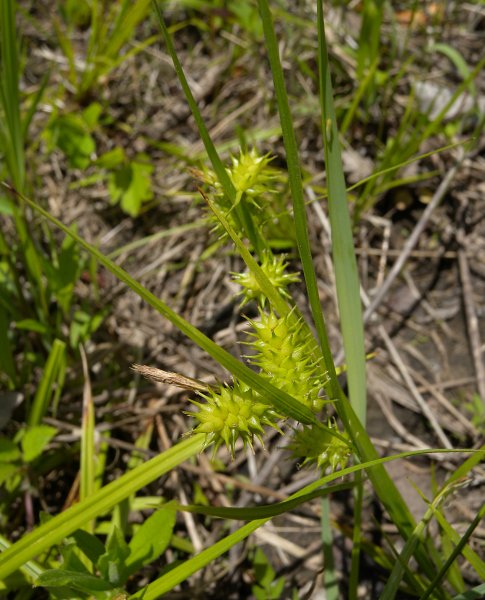
The ligules at the joints of the leaf blades and sheaths are short-membranous. Each fertile culm terminates in an inflorescence consisting of 2-5 non-terminal pistillate spikelets, a single terminal staminate spikelet, and their leafy bracts. Most of these spikelets tend to be loosely clustered together toward the apex of the inflorescence, although a solitary pistillate spikelet is usually widely separated from them below. The pistillate spikelets are ascending to erect and they are nearly sessile, while the staminate spikelet is strongly ascending to erect and it is either nearly sessile or has a stalk up to 1 cm. (0.4") long. The pistillate spikelets are 8-18 mm. long, about 8 mm. across, straight short-cylindrical in shape, and prickly in appearance because of the long beaks of the perigynia. The perigynia (sacs covering most of the pistillate florets) are clustered tightly together on all sides of each pistillate spikelet. Most of these beaked perigynia are widely spreading to slightly ascending, although the lowest perigynia are often slightly descending (declined). Sometimes these spikelets have a few staminate florets and their scales at their apices, where the staminate florets and their scales are narrowly erect and brownish.
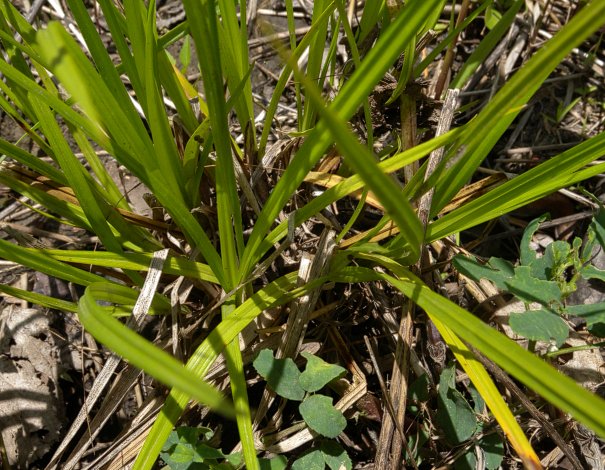
The perigynia are about 4–5.5 mm. long and lanceoloid in shape, tapering abruptly into long slender beaks with a pair of tiny teeth at their apices. These beaks are nearly straight to slightly bent downward relative to the bodies of the perigynia. The bottoms of the perigynia are a combination of bluntly conical and rounded. The exterior of immature perigynia are light green above and whitened below, becoming yellow with age. The perigynia are hairless and their vertical veins, if present, are very faint. The fragile pistillate scales are about one-third as long as the perigynia and inconspicuous; they are ovate, membranous, and green-veined in the center while immature, becoming light brown and withered as they mature. The narrow staminate spikelet is about 10-15 mm. in length, becoming light brown as it ages. The leafy bracts of the inflorescence are similar to the leaves; they are smaller in size above than below. The blooming period occurs during late spring, lasting about 1-2 weeks. The florets are cross-pollinated by the wind. The mature achenes within the perigynia are about 1.5 mm. long, 1 mm. across, and short-obovoid in shape. The root system is fibrous and short-rhizomatous.
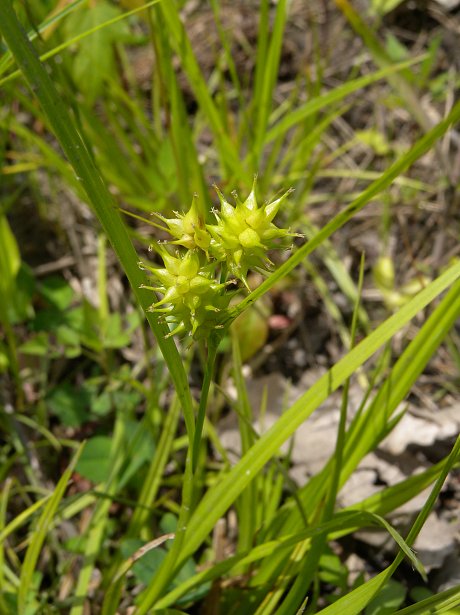
Cultivation: The preference is wet to mesic conditions, full sun to light shade, cool to warm summer temperatures, and a neutral to acidic soil that contains organic matter and either loam or sand.
Range & Habitat: Little Yellow Sedge (Carex cryptolepis) is largely restricted to NE Illinois, where it is native and rare. A few tufted plants of this sedge have been discovered in Champaign County in east-central Illinois, where they were introduced (see Distribution Map). This sedge is found primarily in the Great Lakes area of the upper Midwest, northeastern USA, and adjacent areas of Canada. Illinois lies along its southern range-limit. Habitats include moist meadows, swales, lower banks of streams, shorelines of ponds or small lakes, seeps, and moist areas of fallow fields. This sedge is usually found in higher quality natural areas.
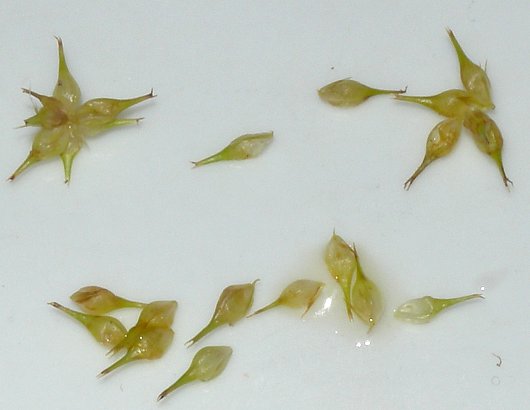
Faunal Associations: Wetland sedges (Carex spp.) along shorelines and in moist meadows provide food and protective cover for a variety of insects. Insects that feed on various parts of these sedges include leaf beetles (Plateumaris spp.), billbugs (Sphenophorus spp.), larvae of miscellaneous flies, miscellaneous seed bugs, aphids (Iziphya spp., Subsaltusaphis spp.), leafhoppers (Cosmotettix spp.), sedge grasshoppers (Stethophyma spp.), larvae of miscellaneous moths, larvae of skippers (Euphyes spp., Poanes spp.), and larvae of a butterfly (Satyrodes eurydice); see the Insect Table for more information. Among vertebrate animals, birds that visit wetlands eat the seeds or seedheads of sedges. This includes geese, ducks, rails, some sandpipers, and sparrows; see the Bird Table for more information. The Canada Goose also feeds on the foliage. Among mammals, the American Black Bear and American Moose eat the foliage of sedges, while the Muskrat sometimes feeds on the culms (Romain et al., 2013; Hamerstrom & Blake, 1939). The foliage or seeds are sometimes eaten by the Snapping Turtle and Eastern Mud Turtle (Ernst et al., 1994).
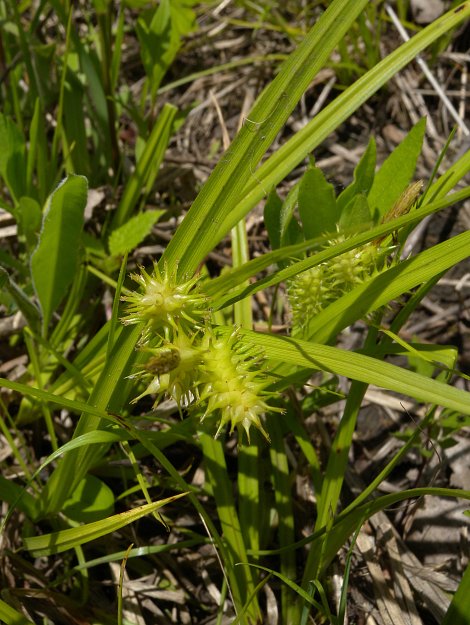
Photographic Location: Exposed ground near a small stream that had been seeded the previous year or two with native plants at Meadowbrook Park in Urbana, Illinois.
Comments: Little Yellow Sedge (Carex cryptolepis) belongs to a small complex of similar sedges that includes the Little Green Sedge (Carex viridula) and Yellow Sedge (Carex flava). Overall, it looks like a dwarf version of Hop Sedge (Carex lupulina). Little Yellow Sedge can be distinguished from Little Green Sedge by the longer beaks of its perigynia, which are about the same length as the bodies of its perigynia. The perigynia of Little Yellow Sedge tend to be slightly smaller in size than those of Yellow Sedge and its pistillate scales are smaller in size, lighter in color, and more inconspicuous than those of Yellow Sedge. The perigynia of Little Yellow Sedge have beaks that are less declined (bent downward) than those of Yellow Sedge. All of the discussed sedges in this complex are found primarily in boreal areas and they prefer moist habitats of various kinds. Another common name of Carex cryptolepis is Northeastern Sedge.

The ligules at the joints of the leaf blades and sheaths are short-membranous. Each fertile culm terminates in an inflorescence consisting of 2-5 non-terminal pistillate spikelets, a single terminal staminate spikelet, and their leafy bracts. Most of these spikelets tend to be loosely clustered together toward the apex of the inflorescence, although a solitary pistillate spikelet is usually widely separated from them below. The pistillate spikelets are ascending to erect and they are nearly sessile, while the staminate spikelet is strongly ascending to erect and it is either nearly sessile or has a stalk up to 1 cm. (0.4") long. The pistillate spikelets are 8-18 mm. long, about 8 mm. across, straight short-cylindrical in shape, and prickly in appearance because of the long beaks of the perigynia. The perigynia (sacs covering most of the pistillate florets) are clustered tightly together on all sides of each pistillate spikelet. Most of these beaked perigynia are widely spreading to slightly ascending, although the lowest perigynia are often slightly descending (declined). Sometimes these spikelets have a few staminate florets and their scales at their apices, where the staminate florets and their scales are narrowly erect and brownish.

The perigynia are about 4–5.5 mm. long and lanceoloid in shape, tapering abruptly into long slender beaks with a pair of tiny teeth at their apices. These beaks are nearly straight to slightly bent downward relative to the bodies of the perigynia. The bottoms of the perigynia are a combination of bluntly conical and rounded. The exterior of immature perigynia are light green above and whitened below, becoming yellow with age. The perigynia are hairless and their vertical veins, if present, are very faint. The fragile pistillate scales are about one-third as long as the perigynia and inconspicuous; they are ovate, membranous, and green-veined in the center while immature, becoming light brown and withered as they mature. The narrow staminate spikelet is about 10-15 mm. in length, becoming light brown as it ages. The leafy bracts of the inflorescence are similar to the leaves; they are smaller in size above than below. The blooming period occurs during late spring, lasting about 1-2 weeks. The florets are cross-pollinated by the wind. The mature achenes within the perigynia are about 1.5 mm. long, 1 mm. across, and short-obovoid in shape. The root system is fibrous and short-rhizomatous.

Cultivation: The preference is wet to mesic conditions, full sun to light shade, cool to warm summer temperatures, and a neutral to acidic soil that contains organic matter and either loam or sand.
Range & Habitat: Little Yellow Sedge (Carex cryptolepis) is largely restricted to NE Illinois, where it is native and rare. A few tufted plants of this sedge have been discovered in Champaign County in east-central Illinois, where they were introduced (see Distribution Map). This sedge is found primarily in the Great Lakes area of the upper Midwest, northeastern USA, and adjacent areas of Canada. Illinois lies along its southern range-limit. Habitats include moist meadows, swales, lower banks of streams, shorelines of ponds or small lakes, seeps, and moist areas of fallow fields. This sedge is usually found in higher quality natural areas.

Faunal Associations: Wetland sedges (Carex spp.) along shorelines and in moist meadows provide food and protective cover for a variety of insects. Insects that feed on various parts of these sedges include leaf beetles (Plateumaris spp.), billbugs (Sphenophorus spp.), larvae of miscellaneous flies, miscellaneous seed bugs, aphids (Iziphya spp., Subsaltusaphis spp.), leafhoppers (Cosmotettix spp.), sedge grasshoppers (Stethophyma spp.), larvae of miscellaneous moths, larvae of skippers (Euphyes spp., Poanes spp.), and larvae of a butterfly (Satyrodes eurydice); see the Insect Table for more information. Among vertebrate animals, birds that visit wetlands eat the seeds or seedheads of sedges. This includes geese, ducks, rails, some sandpipers, and sparrows; see the Bird Table for more information. The Canada Goose also feeds on the foliage. Among mammals, the American Black Bear and American Moose eat the foliage of sedges, while the Muskrat sometimes feeds on the culms (Romain et al., 2013; Hamerstrom & Blake, 1939). The foliage or seeds are sometimes eaten by the Snapping Turtle and Eastern Mud Turtle (Ernst et al., 1994).

Photographic Location: Exposed ground near a small stream that had been seeded the previous year or two with native plants at Meadowbrook Park in Urbana, Illinois.
Comments: Little Yellow Sedge (Carex cryptolepis) belongs to a small complex of similar sedges that includes the Little Green Sedge (Carex viridula) and Yellow Sedge (Carex flava). Overall, it looks like a dwarf version of Hop Sedge (Carex lupulina). Little Yellow Sedge can be distinguished from Little Green Sedge by the longer beaks of its perigynia, which are about the same length as the bodies of its perigynia. The perigynia of Little Yellow Sedge tend to be slightly smaller in size than those of Yellow Sedge and its pistillate scales are smaller in size, lighter in color, and more inconspicuous than those of Yellow Sedge. The perigynia of Little Yellow Sedge have beaks that are less declined (bent downward) than those of Yellow Sedge. All of the discussed sedges in this complex are found primarily in boreal areas and they prefer moist habitats of various kinds. Another common name of Carex cryptolepis is Northeastern Sedge.